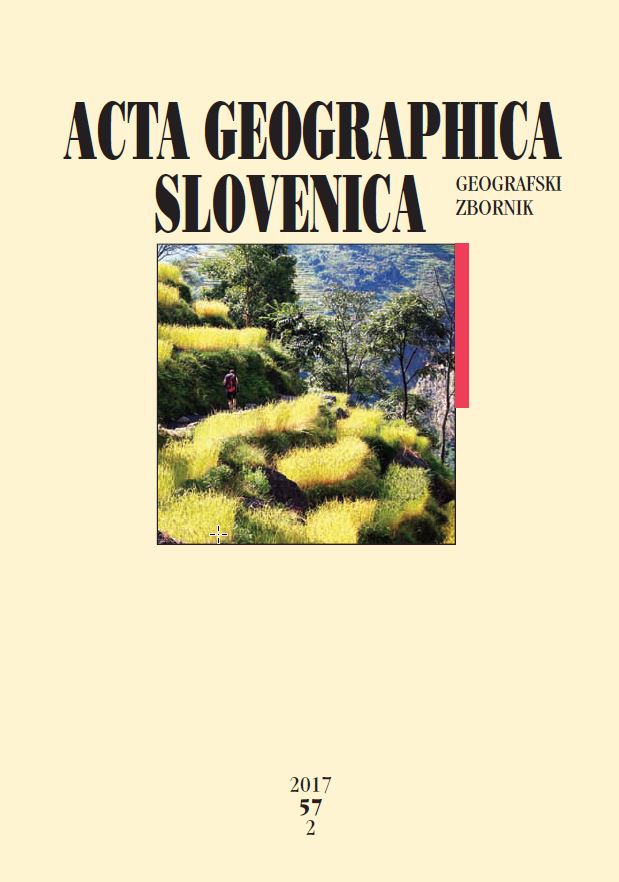Air temperature trends at Mount Śnieżka (Polish Sudetes) and solar activity, 1881–2012
DOI:
https://doi.org/10.3986/AGS.837Keywords:
geography, airtemperature, long-term trends, impact of changes, mean Wolf number, Mount Śnieżka, PolandAbstract
This article discusses air temperature variability at Mount Śnieżka in the Sudetes from 1881 to 2012. It analyzes the relationship between changing trends in mean annual air temperature (Tavg) and solar activity, expressed by the mean annual Wolf number. The characteristic feature of changes in annual mean extremes (Tmax, Tmin) and Tavg at Mount Śnieżka is an upward trend. The increase of Tmin (0.148 °C /10 years) has been twice as fast as that for Tmax (0.069 °C / 10 years). A strong correlation (almost 1.0) was found between the mean annual Wolf number for twenty-two-year cycles of magnetic changes in the Sun and 1988. During the 1989–2012 cycle, there was a strong increase in Tavg and, at the same time, a decrease in the mean annual Wolf number.
Downloads
References
Auer, I. 2004: 100.Hahresbericht des Sonnblick – Vereines fur das Fahr 2002. Wien.
Boryczka, J., Stopa-Boryczka, M., Kossowska-Cezak, U., Wawer, J. 2012: Weryfikacja prognoz okresowych zmian temperatury powietrza w Warszawie w latach 1779–2010. Przegląd Geofizyczny 3-4.
Dubicka, M., Głowicki, B. 2000a: Air temperature and cloudiness at Śnieżka between 1901 and 1998. Prace Geograficzne Uniwersytetu Jagiellońskiego 107.
Dubicka, M., Głowicki, B. 2000b: Ekoklimat Karkonoszy w przekroju wieloletnim w świetle wskaźników kompleksowych. Opera Corcontica 37.
Głowicki, B. 1998: Wieloletnia seria pomiarów temperatury powietrza na Śnieżce. Geoekologiczne Problemy Karkonoszy 1.
Głowicki, B. 2000: 20th -century variability to daily maxima and minima of air temperature in the Sudetic Mountains. Geographia Polonica 73-2.
Głowicki, B. 2001: Zmienność rocznego cyklu termicznego na Śnieżce w XX wieku. Prace i Studia Geograficzne 29.
Głowicki, B. 2003: Symptoms of contemporary warming in the 100-year series of temperature measurements on the Śnieżka Mountain. Acta Universitatis Wratislaviensis - Studia Geograficzne 75-2542.
Harvey, J. W. 2013: The Sun in time. Space Science Reviews 176-1-4. DOI: http://dx.doi.org/10.1007/s11214-010-9726-z
Hoyt, D. V., Schatten, K. H. 1997. The role of the Sun in climate change. Oxford.
IPCC, 2013: 5th assessment report climate change 2013. The physical science basis. Internet: http://www.ipcc.ch (23. 10. 2014).
Karl, T. R., Knight, R. W., Gallo, K. P., Peterson, T. C., Jones, P. D., Kukla, G., Plummer, N., Razuvayev, V. N., Lindesay, J., Charlson, R. J. 1993: A new perspective on recent global warming: Asymmetric trends of daily maximum and minimum temperature. Bulletin of the American Meteorological Society 74-6. DOI: http://dx.doi.org/10.1175/15200477(1993)074%3C1007:anporg%3E2.0.co;2
Karl, T. R., Nicholls, N., Gregory, J. 1997: The coming climate. Scientific American 276-5. DOI: http://dx.doi.org/10.1038/scientificamerican0597-78
Kejna, M. 2006: Zmiany klimatu w Antarktyce. Zmiany klimatyczne w Arktyce i Antarktyce w ostatnim pięćdziesięcioleciu XX wieku i ich implikacje środowiskowe. Gdynia.
Kilcik, A., Özgüç, A., Rozelot, J. P., Yeşilyurt, S. 2008: Possible traces of solar activity effect on the surface air temperature of Turkey. Journal of Atmospheric and Solar-Terrestrial physics 70-13. DOI: http://dx.doi.org/10.1016/j.jastp.2008.07.002
Kożuchowski, K. 1985: Zmienność opadów atmosferycznych Polsce w stuleciu 1881-1980. Acta Geographica Lodziensia 48.
Lockwood, M. 2008: Recent changes in solar outputs and the global mean surface temperature. III. Analysis of contributions to global mean air surface temperature rise. Proceedings of the Royal Society A 464. DOI: http://dx.doi.org/10.1098/rspa.2007.0348
Lockwood, M. 2012: Solar influence on global and regional climates. Survey in geophysics 33-3-4. DOI: http://dx.doi.org/10.1007/s10712-012-9181-3
Lockwood, M, Frölisch, C. 2007: Recent oppositely directed trends in solar climate forcings and the global mean surface air temperature. Proceedings of the Royal Society A 463. DOI: http://dx.doi.org/10.1098/rspa.2007.1880
Lorenc, H. 1994: Symptomy zmian klimatu w strefach ograniczonych wpływów antropogenicznych. Materiały Badawcze IMGW 19.
Lorenc, H., Suwalska-Bogucka, M. 1995: Metody obliczania średniej dobowej temperatury i wilgotności względnej powietrza. Materiały Badawcze IMGW 24.
Nojarov, P. 2012: Changes in air temperatures and atmosphere circulation in high mountainous parts of Bulgaria for period 1941-2008. Journal of mountain science 9-2. DOI: http://dx.doi.org/10.1007/s11629-012-2224-x
Nosek, M. 1972: Metody v klimatologii. Praha.
Raspopov, O.M., Dergachev, V.A., Kolström, T. 2004: Hale cyclicity of solar activity and its relation to climate variability. Solar physics 224-1-2. DOI: http://dx.doi.org/10.1007/s11207-005-5251-8
Scafetta, N., West, B. J. 2006: Phenomenological solar signature in 400 years of reconstructed Northern Hemisphere temperature record. Geophysical research letters 33-17. DOI: http://dx.doi.org/10.1029/2006GL027142
Schönwiese, C. D., Rapp, J. 1997: Climate trend atlas of Europe - based on observations 1891–1990. Kluwer. DOI: http://dx.doi.org/10.1007/978-94-015-8818-8
Souza Echer, M. P., Echer, E., Nordemann, D. J. R., Rigozo, N. R. 2009: Multi-resolution analysis of global surface air temperature and solar activity relationship. Journal of atmospheric and solar-terrestrial physics 71-1. DOI: http://dx.doi.org/10.1016/j.jastp.2008.09.032
Svensmark, H., Friis-Christensen, E. 1997: Variation of cosmic ray flux and global cloud coverage—a missing link in solar-climate relationships. Journal of atmospheric and solar-terrestrial physics 59-11. DOI: http://dx.doi.org/10.1016/s1364-6826(97)00001-1
Urban, G. 2010: Ocena wybranych metod obliczania średniej dobowej, miesięcznej i rocznej wartości temperatury powietrza (na przykładzie Sudetów Zachodnich i ich przedpola). Opera Corcontica 47-1.
Urban, G. 2013: Evaluation of accuracy of selected methods of calculation of the daily mean air temperature depending on atmospheric circulation (the case study of the Western Sudety Mountains and their foreland). Opera Corcontica 50-S.
Usoskin, I. G., Schüssler, M., Solanki, S. K., Mursula, K. 2005: Solar activity over the last 1150 years: Does it correlate with climate? Proceedings 13th Cool Stars Workshop. Hamburg. Internet: http://www.mps.mpg.de/dokumente/publikationen/solanki/c153.pdf (28. 3. 2014).
Wibig, J., Głowicki, B. 2002: Trends of minimum and maximum temperature in Poland. Climate research 20. DOI: http://dx.doi.org/10.3354/cr020123
Internet:
Internet 1: http://commons.wikimedia.org/wiki/File:Sniezka_Old_02.jpg/ (28. 3. 2014).
Internet 2: SILSO data. Royal Observarory of Belgium. Brussels (http://www.sidc.be/silso/datafiles) (28. 3. 2014).
Internet 3: http://science.nasa.gov/science-news/science-at-nasa/2013/05aug_fieldflip/ (28. 3. 2014).
Downloads
Published
How to Cite
Issue
Section
License

This work is licensed under a Creative Commons Attribution-NonCommercial-NoDerivatives 4.0 International License.









